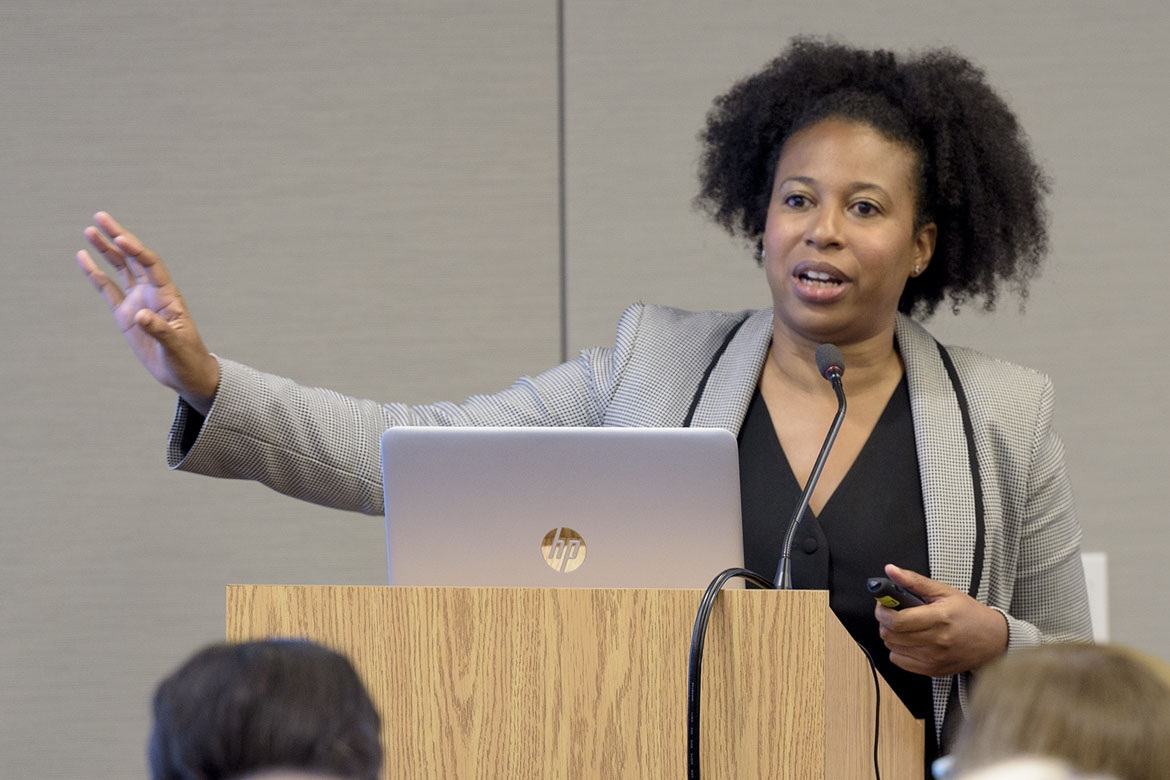Creating a more equitable health care system will be a long journey. It’s one the AMA has committed to, most notably by establishing the Center for Health Equity.
That journey, in many respects, begins in training tomorrow’s physicians to understand current disparities in care and work toward eradicating inequities.
“We must understand how we come to the decisions that we make and how they potentially exacerbate or make better equities that exist,” Aletha Maybank, MD, MPH, the AMA’s new chief health equity officer, said during a recent education session at the AMA.
“And so a piece of our work is normalizing conversations, meaning how do we build a shared analysis? How do we educate on different contributions of equity that we know? And how do we foster dialogue amongst ourselves in meaningful ways and sometimes uncomfortable ways about these issues,” said Dr. Maybank, pictured above.
As part of the session, Susan E. Skochelak, MD, MPH, AMA group vice president for Medical Education, highlighted at least four methods and programs used by projects within the AMA’s Accelerating Change in Medical Education consortium that are working to improve health equity.
Creating a more diverse physician work force
Morehouse School of Medicine has worked consistently to increase diversity in the health professional and scientific workforce. One key method for doing this is giving students who may on paper look less prepared for medical school—particularly those with lower entrance-exam scores—an opportunity to shine.
Morehouse has established a strong culture of student support,” Dr. Skochelak said. “Students work in teams to ensure academic success. Administration tracks student performance and offers additional support to students who would benefit from targeted improvement. As a result, Morehouse students do very well on the USMLE exams.”
Using an interdisciplinary approach
Interprofessional teams have been a major focus of the AMA’s work in medical training. One program Dr. Skochelak highlighted was NeighborhoodHELP at Florida International University Herbert Wertheim College of Medicine.
The longitudinal service learning program offers household-centered care teams consisting of trainees from a number of disciplines. The teams meet patients in the community or at their homes throughout underserved areas of Miami-Dade County.
Working with patients from day one
Patient navigation—the practice of allowing medical students to help disadvantaged patients receive the care they need in a complex health system—is another area that Dr. Skochelak mentioned. In particular, she highlighted a program at Case Western Reserve University School of Medicine in which first-year medical students are paired with newly arrived refugee families in a community health center.
“Students often don't have experience in the same way that patients and families do with the health care system,” she said. “By being trained as patient navigators where they go out and they listen to and help with the coordination of the services that the family needs, they are able to both help and impact the health of the family, community and the patient. They also learn about what's going on in those communities.”
Going into underserved communities
The final program Dr. Skochelak mentioned was the California Oregon Medical Partnership to Address Disparities in Rural Education and Health (COMPADRE). A collaboration between Oregon Health & Science University and University of California, Davis, health care systems, institutional sponsors and a network of federally qualified health centers, this program is part of the recently announced AMA Reimagining Residency initiative.
COMPADRE aims to reduce disparities in care by enhancing the resident physician work force in rural areas, eventually equipping those trainees with the necessary skills to thrive practicing in lower-income communities.
“We started our work wanting to close the gaps in the way in which physicians were trained and [helping them gain an understanding of] the way the health care system has evolved,” Dr. Skochelak said. “Understanding the social determinants of health, understanding how to work with communities and affect health outcomes becomes an important new element in a way in which physicians are being trained.”
Other presenters during the session included: Richard Hofrichter, PhD, of the National Association of County and City Health Officials, who spoke on advancing public narrative for health equity and social justice; and Michelle Morse, MD, MPH, co-founder of the social medicine consortium and an assistant professor at Harvard Medical School who spoke on intensifying the focus on social medicine in medical education.
The work each of these programs displays falls within the domain of health systems science. The AMA’s Health Systems Science textbook was developed by the consortium to help students learn how to navigate the changing landscape when they enter practice, especially as the nation’s health care system moves toward value-based care.
Two additional resources on health systems science were released in recent months. The AMA’s new Health Systems Science Review book, published by Elsevier, is the first study tool of its kind to help physicians-in-training and other health professionals, as well as their instructors, evaluate competencies in Health Systems Science. The Association also released a series of free, online education modules to help students develop competencies in Health Systems Science. The first six modules in the new Health Systems Science Learning Series are available for free through the AMA Ed Hub™.




